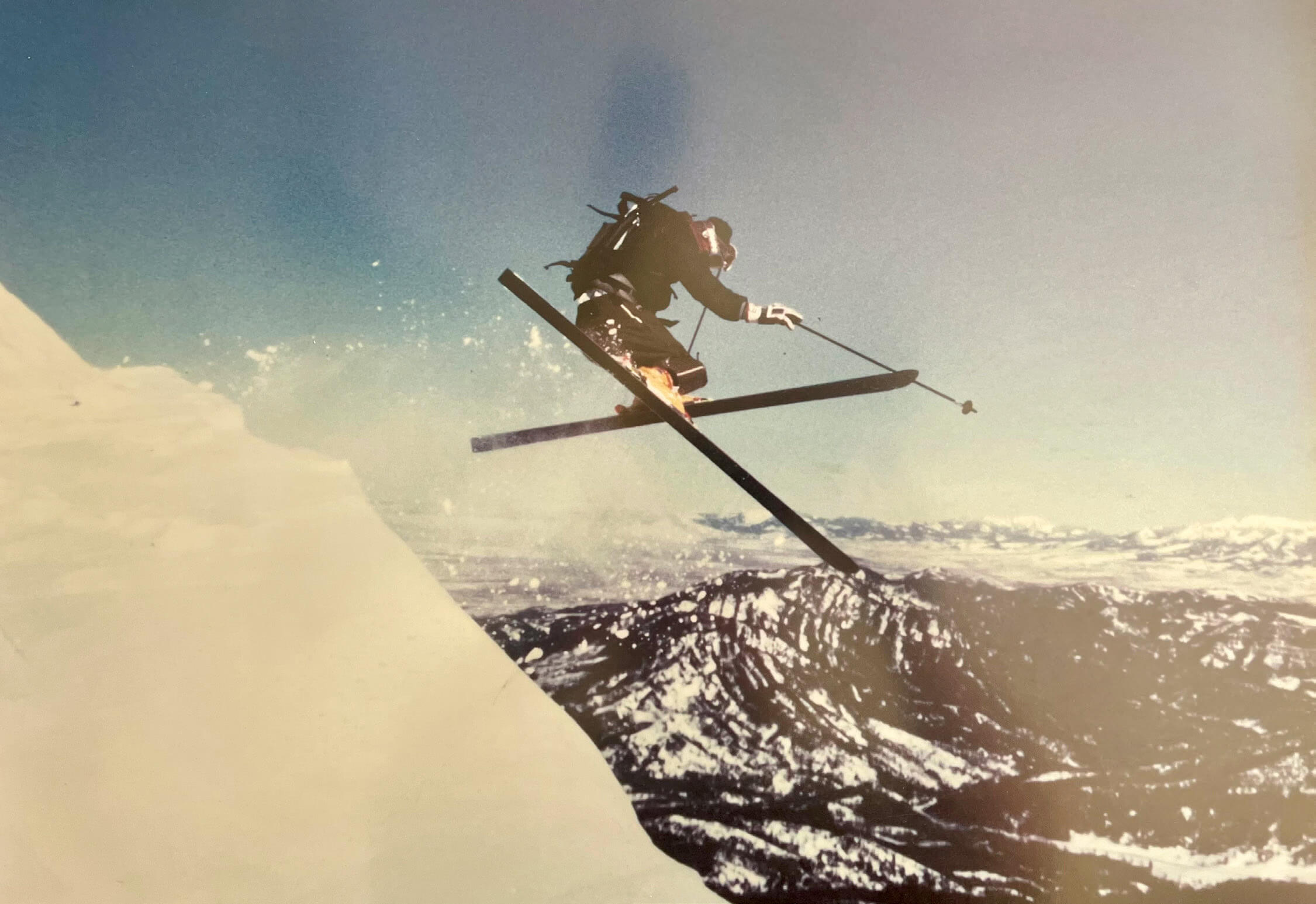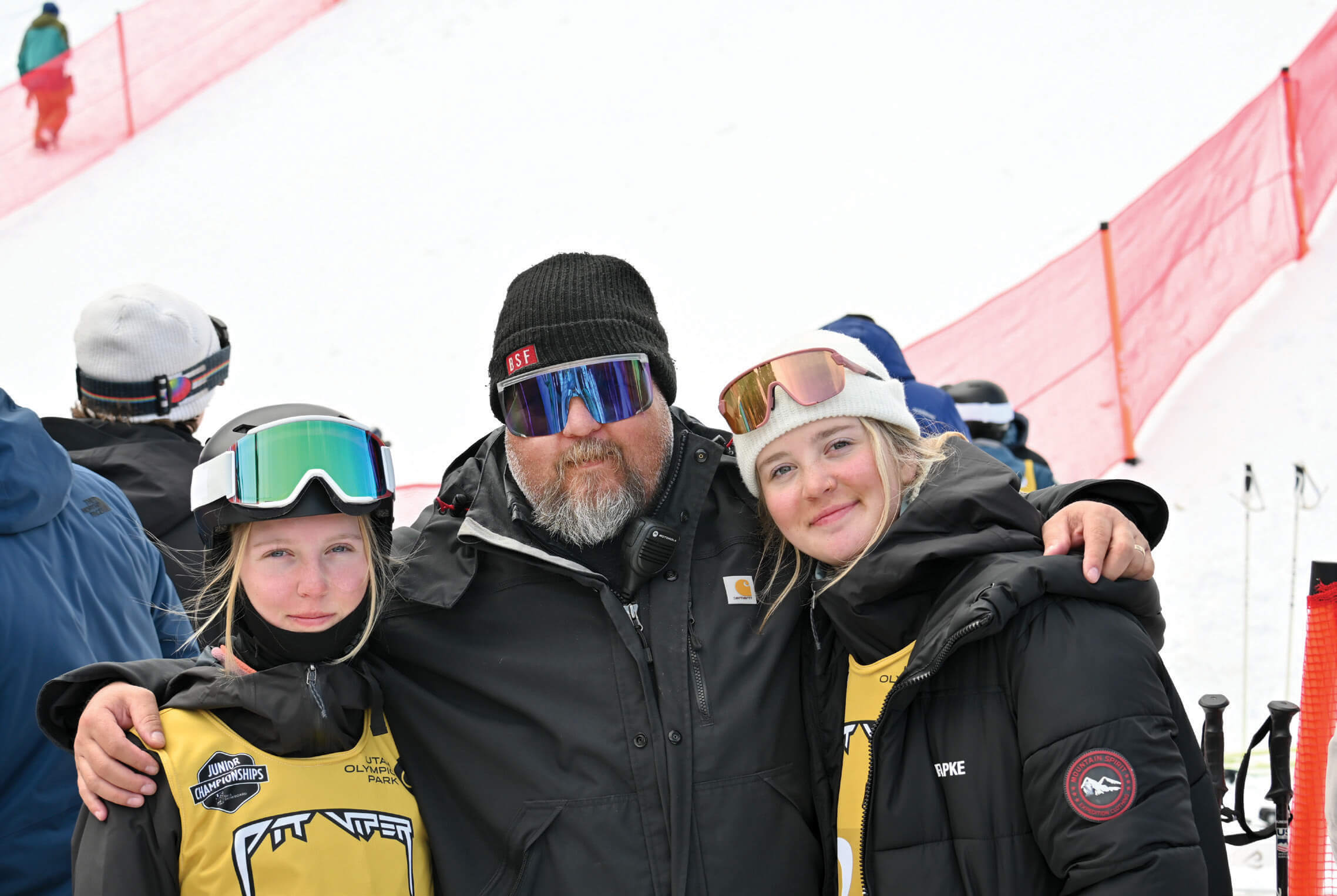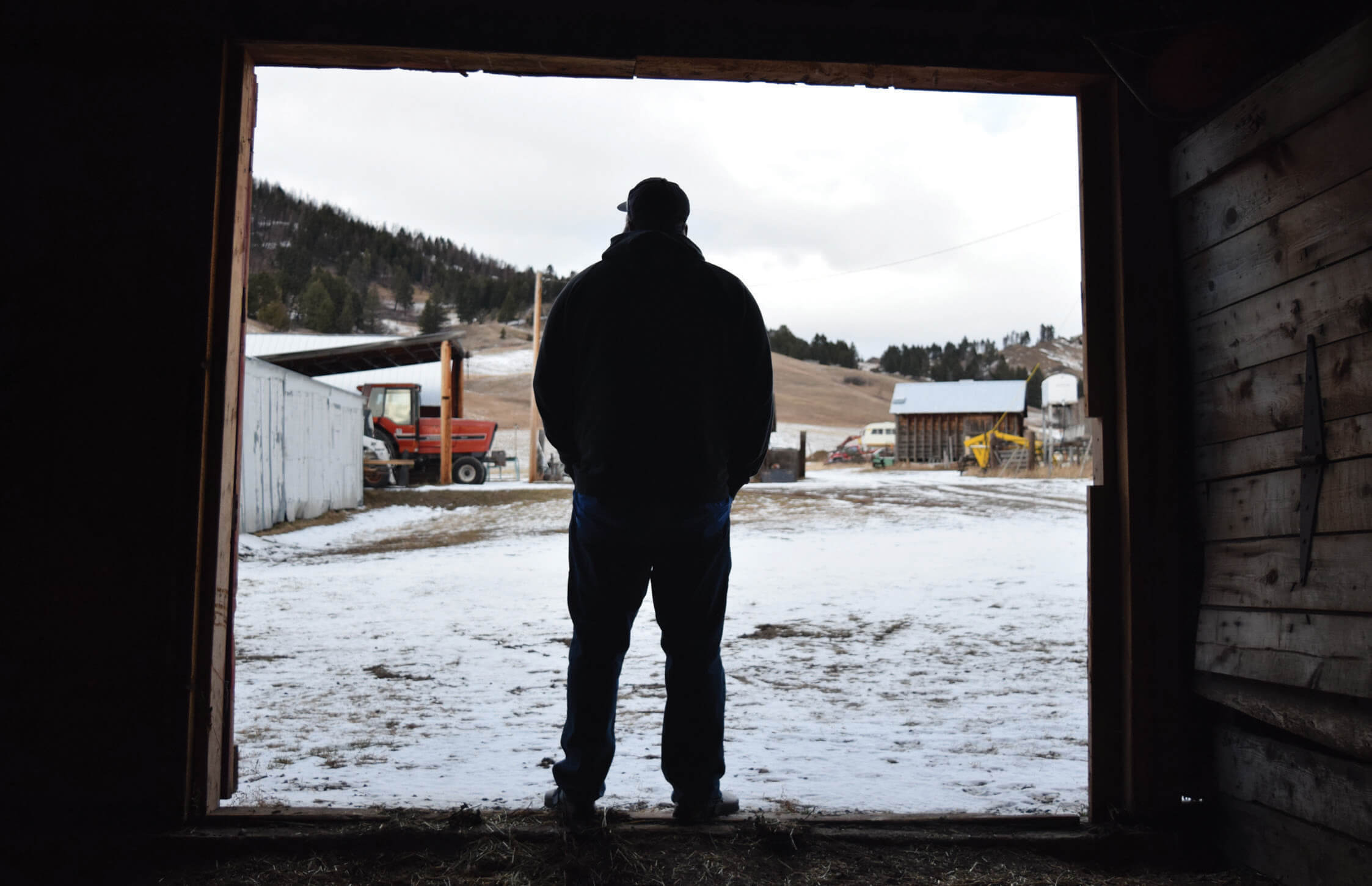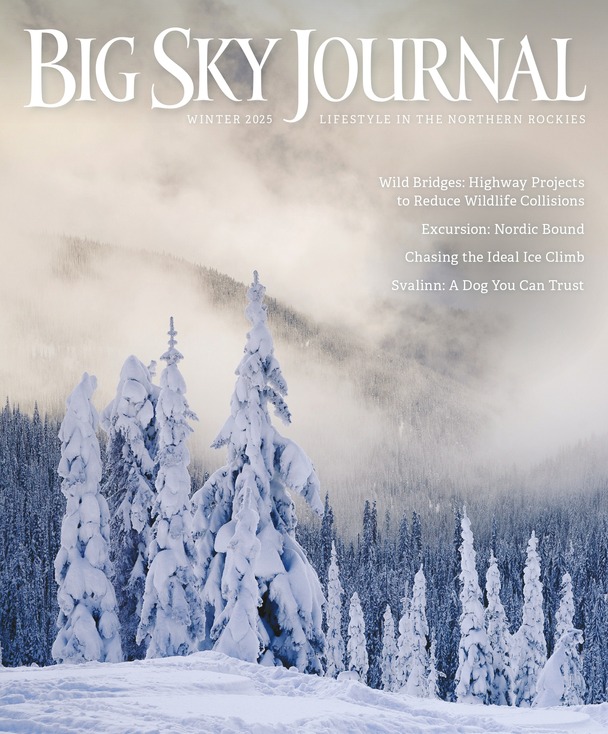
21 Nov Local Knowledge: A Lifetime in the Making
In the late 1970s, when Mike Papke was 5 years old, his older brothers took him to Bridger Bowl Ski Area just outside of Bozeman, Montana and went straight to the top of the Bronco run — an area notorious for large, knee-bashing moguls. They directed him to ski down. One run. Two runs. Three runs. They skied Bronco over and over again, finally stopping when the lifts closed. Then, they returned to their home just a few miles away in Bridger Canyon, exhausted and exhilarated. Papke, now 51, has been shredding moguls — either as an athlete or coach — ever since.

Papke and Heather McPhie Watanabe hike the Ridge at Bridger Bowl in the 1990s. The two developed a close bond as coach and athlete, leading to Watanabe’s two Olympic appearances and a pro mogul career that took her around the world. | HEATHER MCPHIE WATANABE
Papke is now the freestyle program director for the Bridger Ski Foundation (BSF), an organization he’s been a part of since the 1980s, when, as a teen, he and a group of like-minded mogul skiers convinced the nonprofit to start a freestyle team. At the time, skiing moguls was one of the coolest things you could do on the mountain, and kids growing up in the Gallatin Valley were starting to organize around the increasingly popular sport. Because there were no competitions in Montana, the teens often traveled to Salt Lake City on their own dime, doing anything they could for a chance to rip a new mogul course. When Papke was in seventh grade, he pooled money together with some of the older athletes to buy an old van, which they promptly retrofitted with couches and drove to Utah to compete.
“We were a ragtag group of skiers that traveled out of state to participate in events as they didn’t exist in Montana,” Papke recalls with a laugh. “It’s amazing how trusting our parents were.”
With more and more interested skiers, and a ton of energy, they realized they needed a more structured program if they wanted to keep up with the growing scene.
“We pitched it to BSF, and they invited us in with open arms,” says Papke.
Soon after, a coach was hired — nicknamed Johnny Mogul, of course — and the program was off and running. By the late 1980s, some of the Bridger skiers were competing on the pro circuit, and Missoula’s Andy Hayes was organizing a new northern division of the United States Skiing and Snowboard Association — now known simply as U.S. Ski & Snowboard. The first sanctioned mogul competition in Montana was held in 1987 at Montana Snowbowl near Missoula.
As a competitor, Papke had success in the early ’90s and eventually worked his way onto the U.S. National Team. Mogul skiing was set to debut at the 1992 Winter Olympics in France, and the sport was peaking just at the right time. Papke, however, was already looking toward the future. He started coaching in 1990 and took over BSF’s mogul program in 1993. An injury in 1995 and a marriage in 1997 meant that time for competitions was harder to come by, but, by then, it was clear that Papke was a natural at teaching the next generation of skiers.
“Mike is steadfast in stewarding freestyle skiing in Montana and across the country,” says Evan Weiss, BSF’s executive director. “On the hill, he has created a culture of fun, inclusivity, and success — a hard balance to find. He is one of BSF’s strongest ambassadors and his fingerprints are all over the club.”

Papke, left, talks things over with his daughters during a competition.
Two-time Olympian Heather McPhie Watanabe grew up in Bozeman and, as a young girl, was an aspiring gymnast who also loved skiing. Early on, her family skied together at Big Sky, and she remembers skiing Mad Wolf — a long, steep mogul run — over and over with anyone who would go with her. In 1996, at age 12, Watanabe decided to move on from competitive gymnastics and join BSF’s ski program. Since there was no aerial coach, and ski ballet was on its way out, the mogul team seemed like the obvious choice. She remembers meeting Papke on sign-up night.
“He was certainly part of the draw for me because he was just really welcoming,” recalls Watanabe. “I think he probably took the time to talk to every single kid that night and was just really approachable and kind.”
Watanabe admits that, although she liked skiing moguls, she wasn’t exactly the best when she first started out. “I was not a natural talent at mogul skiing,” she says. “Nobody would have guessed I was going to the Olympics, including myself.”
What Watanabe had, however, was determination. Competitive gymnastics had required that, and it translated perfectly into skiing. She put her head down and went to work, with Papke guiding her along the way.

Papke coached both of his daughters — Meg, left, and Makayla, right — through the Bridger Ski Foundation (BSF), where he is head of the freestyle program.
“Papke knew me as the little girl who loved to ski, the girl who was horrendous at skiing but kept showing up, and the one that crashed and got back up. He was always there with a smile on his face,” says Watanabe. “Coming from gymnastics, I was a really serious girl, and he embraced me exactly how I was and helped me just not be quite so serious. I’ll just really forever be grateful to him.”
More important to Watanabe is that Papke isn’t just creating good skiers, he’s shaping good people as well. “It’s not really about the outcome or the particulars of one event; it’s so much bigger than that for him,” Watanabe says. “It’s about giving kids a positive experience and helping raise good humans. It was like, show up, do the right thing, be a good person. Have fun, and the results are kind of the cherry on top.”
Papke, who now manages 100 skiers annually in the BSF freestyle program, still stands by that perspective when coaching kids today. “Skiing is about more than results. It’s about the friendships, the community, and the lifelong love of being in the mountains,” he says. “If athletes leave this program with strong skills, confidence, and a smile on their face, then we’ve done our job.”
Today, Papke is continuing to help build the next generation of freestyle skiers. In addition to leading the BSF program — which also includes big-mountain and terrain-park skiers — he also serves as the chair of U.S. Ski & Snowboard’s Freestyle Sports Committee, which represents the interests of the freestyle community within the United States. Mogul skiing isn’t as popular as it was 25 years ago, but he’s embraced the sport’s progression. The dual-mogul skiing format will make its Olympic debut in 2026, which should help with visibility.
“I think it’ll help draw new fans and give athletes more opportunities to showcase their skills,” Papke says. “It’s fast, it’s head to head, and it shows off the athleticism of the sport. Freestyle skiing has an exciting future.”

BSF’s new headquarters, recently purchased by the organization and slated for renovation, will be the nonprofit’s first true home since it was founded in 1936.
With increasing participation — more than 1,000 total participants, 30 distinct program offerings, 140 coaches, and 600 volunteers — BSF is looking toward the future. The nonprofit organization recently purchased a new building, which it will renovate into its first-ever headquarters since the foundation’s inception in 1936. Plans include indoor and outdoor training areas, office and meeting space, ski tuning and waxing equipment, and plenty of storage.
“The headquarters will be a dedicated space that strengthens club culture and encourages more teens to stay engaged,” says Weiss. “It will be the hub of Bozeman’s ski culture for the next 90 years.”
A space like the new headquarters, which will allow for year-round training, might keep elite athletes like Watanabe from eventually moving on to larger, full-time programs. After eight years with BSF, Watanabe was offered a scholarship to a ski program in Colorado and made the U.S. National Team soon after. She went on to a long career as a podium-topping pro on the North American Tour and World Cup circuits, and was the first mogul skier to snag a coveted Red Bull athlete sponsorship. She competed at the Vancouver Olympics in 2010, won the U.S. National title in 2013, and competed in her final Olympics at Sochi in 2014 before retiring.
Even with all that success, as coaches changed and she traveled farther and farther from home, Watanabe credits Papke as her biggest inspiration. She still has an old voicemail from him saved on her phone from her first Olympic appearance all those years ago, and she also kept a belt buckle that Papke gave her after she won her last Northern Division championship. Watanabe wore the buckle throughout her entire career, every single day she skied.

Papke surveys his farm in Bridger Canyon, where his family homesteaded generations ago in the late 1800s. He still calls the farm home today.
“If somebody says, ‘Well, who was your coach?’ It’s Papke,” she says. “I had tons of other coaches, and they were lovely. But [Papke] was my foundational coach. He was my rock.”
These relationships and moments are what keep Papke coming back, year after year. Coaching is even more special these days, as both of his daughters are competing in moguls — Meg was the Grand Prix champion in the Northern Division and finished ninth in dual moguls at the U.S. Freestyle Championships last year. Makayla, his oldest, has competed for BSF and will soon make her transition to coaching. Papke is also now teaching several of his former athletes’ children — a full-circle moment that isn’t lost on the lifelong skier.
“Watching kids fall in love with skiing, push past their limits, and discover what they’re capable of is what keeps me going,” he says. “Every season, there’s that moment when something clicks for an athlete, whether it’s landing a new trick, skiing their best run, or just finding confidence. Being part of that never gets old.”
Brian Hurlbut is the author of Insiders’ Guide to Yellowstone and Grand Teton (Globe Pequot) and Montana: Skiing the Last Best Place (Great Wide Open), and his writing appears regularly in regional publications. He lives in Big Sky, Montana where he enjoys the trails, mountains, rivers, and roads.




No Comments